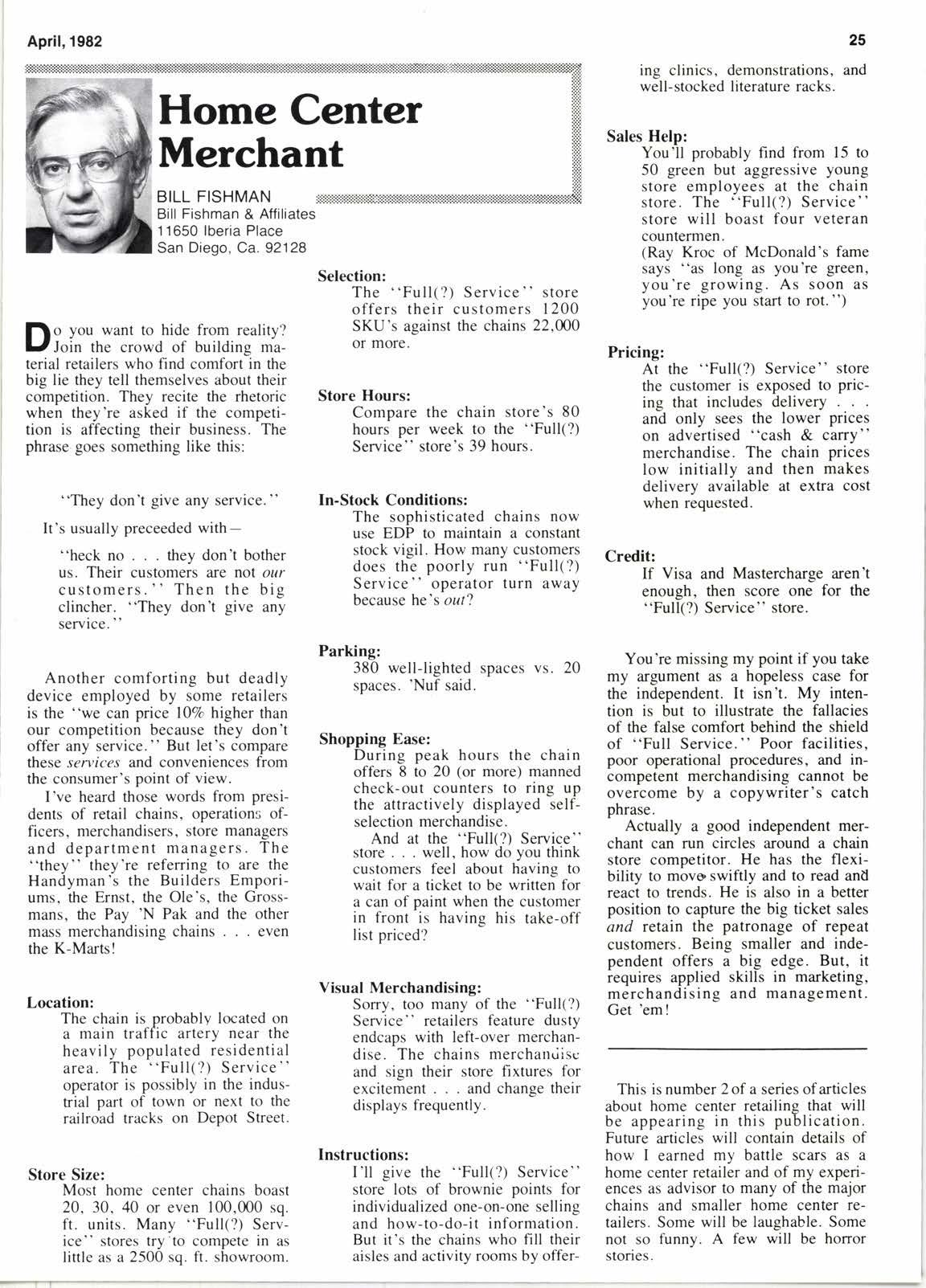
3 minute read
Home Center Merchant
Bill Fishman
Bill Fishman & Affiliates
11650 lberia Place San Diego, Ca.92128 flo you want to hide from reality? l/Join the crowd of building material retailers who find comfort in the big lie they tell themselves about their competition. They recite the rhetoric when they're asked if the competition is affecting their business. The phrase goes something like this:
"They don't give any service."
It's usually preceeded with"heck no . they don't bother us. Their customers are not our customers. " Then the big clincher. "They don't give any service. "
Another comforting but deadly device employed by some retailers is the "we can price l07o higher than our competition because they don't offer any service." But let's compare these services and conveniences from the consumer's point of view.
I've heard those words from presidents of retail chains, operations officers, merchandisers, store managers and department managers. The "they" they're referring to are the Handyman's the Builders Emporiums, the Ernst, the Ole's, the Grossmans, the Pay 'N Pak and the other mass merchandising chains . even the K-Marts!
Location:
The chain is probablv located on a main traffic artery near the heavily populated residential area. The "Full(?) Service " operator is possibly in the industrial part of town or next to the railroad tracks on Depot Street.
Store Size:
Most home center chains boast 20, 30, 40 or even 100,000 sq. ft. units. Many "Full(?) Service" stores try to compete in as little as a 2500 sq. ft. showroom.
Selection: The ''Full( ?) Service " store offers their customers 1200 SKU's against the chains 22,n0 or more.
Store Hours: Compare the chain store's 80 hours per week to the "Full(?) Service" store's 39 hours.
In-Stock Conditions:
The sophisticated chains now use EDP to maintain a constant stock vigil. How many customers does the poorly run "Full(?) Service" operator turn away because he's oul?
Parking: 380 well-lighted spaces vs. 20 spaces. 'Nuf said.
Shopping Ease: During peak hours the chain offers 8 to 20 (or more) manned check-out counters to ring up the attractively displayed selfselection merchandise.
And at the "Full(?) Service" store . well, how do you think customers feel about having to wait for a ticket to be written for a can of paint when the customer in front is having his take-off list priced?
Visual Merchandising: Sorry, too many of the "Full(?) Service" retailers feature dusty endcaps with left-over merchandise. The chains merchantiisc and sign their store fixtures for excitement and change their displays frequently.
Sales Help:
You'll probably find from 15 to 50 green but aggressive young store employees at the chain store. The "Full(?) Service' ' store will boast four veteran counterrnen.
(Rav Kroc of McDonald's fame sayi "as long as you're green, you're growing. As soon as you're ripe you start to rot. ")
Pricing:
At the ' 'Full(?) Service' ' store the customer is exposed to pricing that includes delivery and only sees the lower prices on advertised "cash & carry" merchandise. The chain prices low initially and then makes delivery available at extra cost when requested.
Credit: lnstructions: I'll give the "Full(?) Service" store lots of brownie points for individualized one-on-one selling and how-to-do-it information. But it's the chains who fill their aisles and activity rooms by offer-
If Visa and Mastercharge aren't enough, then score one for the "Full(?) Service" store.
You're missing my point if you take my argument as a hopeless case for the independent. It isn't. My intention is but to illustrate the fallacies of the false comfort behind the shield of "Full Service." Poor facilities, poor operational procedures, and incompetent merchandising cannot be overcome by a copywriter's catch phrase.
Actually a good independent merchant can run circles around a chain store competitor. He has the flexibility to move swiftly and to read antl react to trends. He is also in a better position to capture the big ticket sales and retain the patronage of repeat customers. Being smaller and independent offers a big edge. But, it requires applied skills in marketing, merchandising and management. Get 'em!
This is number 2 of a series of articles about home center retailine that will be appearing in this publication. Future articles will contain details of how I earned my battle scars as a home center retailer and of my experiences as advisor to many of the major chains and smaller home center retailers. Some will be laughable. Some not so funny. A few will be honor stories.










